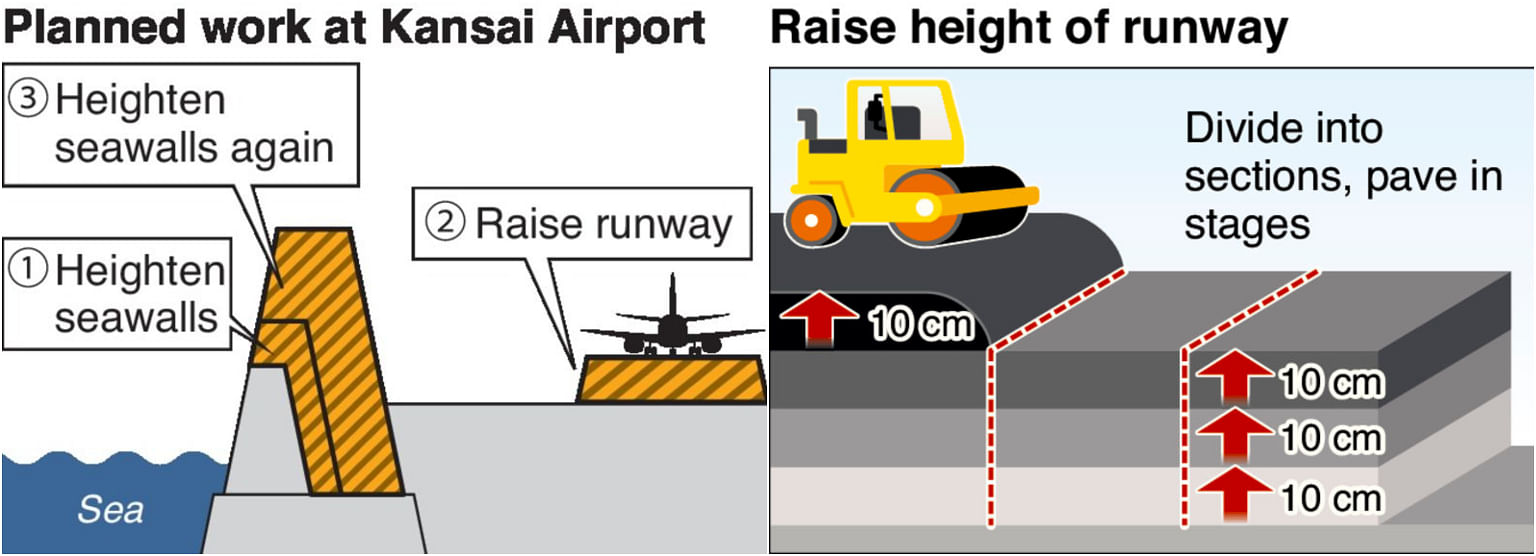Osaka's sinking Kansai Airport to raise runway after last year's flooding by Typhoon Jebi
Sign up now: Get insights on Asia's fast-moving developments
Follow topic:
TOKYO (THE YOMIURI SHIMBUN/ASIA NEWS NETWORK) - Japan's Land, Infrastructure, Transport and Tourism Ministry intends to raise the height of the runway and taxiways at Kansai Airport's first airport island, which was flooded by Typhoon No. 21 (Typhoon Jebi) last autumn, The Yomiuri Shimbun has learnt.
Along with work to increase the height of seawalls that block incoming high waves, construction will begin to elevate the 3,500m-long, 60m-wide runway by about 1m using asphalt, sources said.
The ministry plans to divide the runway area into construction sections so as not to affect the take-off and landing of aircraft. A special method will be used to layer the pavement and raise the runway height in 10cm increments.
The project is expected to require at least about three years to complete.
The ministry has opened discussions with Kansai Airports, the airport's operating firm, and will begin work to elevate the runway as early as fiscal year 2019.
The runway is currently about 3m above sea level. Construction will be carried out mainly at night so as not to obstruct the operation of aircraft. The height will be gradually increased using damage-resistant asphalt. The ministry plans to first work on the seawalls before raising the runway and taxiways, and then resume work to elevate the seawalls.
Kansai Airport is located on a man-made island, a rarity in other countries. The airport has gradually sunk since it opened in 1994. The airport's runways and taxiways were paved several times and raised by about 20cm, along with other structures, from 2007 to 2008.

The upcoming project will be the first large-scale undertaking to raise the runway by a metre.
It has been noted that the seawalls need to be elevated because the first island - one of two airport islands originally constructed - sinks about 6cm per year. However, the height of seawalls surrounding runways must be limited so that airplanes can safely land and take off. For that reason, the runways and other structures must be elevated at the same time as the seawalls. Raising the runway alone is expected to cost several billion yen, a cost that had discouraged the undertaking of it.
But the transport ministry determined that drastic measures must be taken to raise the height of the runway and seawalls, as operations on the first island were suspended for about 10 days due to the flooding from the typhoon last autumn that generated waves more than 5m high, the highest ever recorded in Japan.
Disaster prevention measures appropriated for the airport are estimated to be 54 billion yen (S$667.7 million). However, the sum could drastically increase due to the work to raise the runway, taxiways and other structures.
The ministry's study panel, set up following the flooding last autumn, has noted the importance of raising the seawalls to prevent flooding, among other measures. It is possible that such techniques will be used at other offshore airports potentially vulnerable to high waves.

